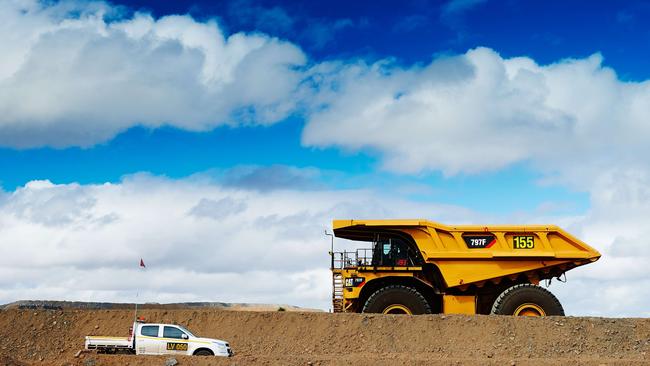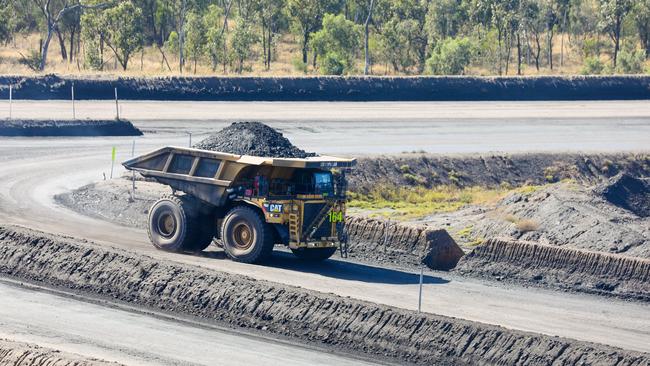Black outlook for coal: BHP slashes mine values
BHP has cut up to $US1.3bn from the value of its NSW thermal coal mines as it looks to offload the assets, and amid China bans.

Business
Don't miss out on the headlines from Business. Followed categories will be added to My News.
BHP has slashed up to $US1.3bn ($1.7bn) from the value of its NSW thermal coal mines as it looks to offload the out of favour assets, citing the poor outlook for Australian energy coal and the difficulty of recovering tax losses at the operations, as the company also cut production expectations for its coking coal mines.
BHP latest quarterly production report show the mining giant booked a record first half of the year at its WA iron ore operations, although December quarter shipments fell 3.5 per cent to 70.8 million tonnes compared to the previous period.
Strong prices for the steel making commodity are likely to deliver a big boost to first-half profits, with BHP realising an average $US103.78 a tonne at the port for its iron ore, up from $US78.30 in the first half of the previous year.
But while its dominant iron ore division put in a flying start to the fiscal year, its coal operations have suffered from China’s bans on Australian coal and from bad weather.
The mining giant said its half-year financial report would include a $US1.15bn to $US1.25bn writedown on the value of its Mt Arthur coal mine in NSW as it looks to sell the operations.
“This reflects current market conditions for Australian thermal coal, the strengthening Australian dollar, changes to the mine plan and updated assessment of the likelihood of recovering tax losses,” BHP said.
Mt Arthur produced 3.2 million tonnes of coal in the December quarter, down 11 per cent from the September period on the back of poor weather in NSW. It produced 6.9 million tonnes in the first half of the year.
Production at its Queensland coking operations also fell, with BHP saying it was still closely monitoring China’s bans on Australian coal for likely impacts on total export volumes over the year.
Metallurgical coal output from its Queensland operations was steady at 17.1 million tonnes, after producing 17 million tonnes of coal in the September quarter, itself an 18 per cent fall from the June period – although it was 5 per cent above the same time in 2019.
But while BHP did not disclose any direct impact on output from China’s coal bans, the trade war slashed the prices it received for coking coal. BHP received an average $US106.30 for its premium metallurgical coal in the first half of the year, down 31 per cent from the first half of the previous financial year.
Thermal coal prices also tumbled, to an average $US44.35 a tonne, down 24 per cent.
BHP said wild weather in northern and central Queensland could still impact total annual production this fiscal year, after a wet finish to 2020.
BHP has said it expects its Queensland coal operations to export 71-77 million tonnes of coal this financial year, but said on Wednesday it now expects the final total to land in towards the bottom end of the range.
Its Pilbara network shipped 144.1 million tonnes of iron ore in the first half of the fiscal year, however, a record rate as the mining giant capitalised on urging prices.
BHP had previously flagged a softer December quarter, saying output was likely to be slowed as it began to integrate its new South Flank mine into its existing infrastructure, and conducted maintenance on unloading equipment at its Port Hedland operations.
BHP’s Pilbara network exported 73.4 million tonnes of iron ore during the September period, and the company has said it expects to export 276-286 million tonnes of iron ore this financial year.
But with copper’s recent bull run underlining talk it will be the coming commodity over the next decade, BHP’s copper assets also put in a strong run in the December quarter.
Copper is sitting at just below $US8000 a tonne this week, having tested eight year highs of close to $US8150 earlier in January.
BHP’s global operations produced 428,100 tonnes of copper in the quarter, up 4 per cent on improved throughput at its giant Escondida mine in Chile.
And, in a good sign for BHP’s on-again off-again plans for the expansion of its Olympic Dam mine, the operation put in a solid half year’s performance, producing 99,100 tonnes of copper in the six months to the end of December, putting it on track to achieve the 200,000 tonne a year BHP sees as its normal nameplate capacity.
In October BHP axed its most recent Olympic Dam expansion plan, known as BFX, without any obvious alternative in sight. But the company has long said it won’t push the button on any expansion of capacity at the giant deposit until it has the trouble-plagued processing plant under control and able to produce in a consistent fashion.
But, in signs an alternative future may lie in development of a new mine not far away, BHP said it had shifted control of its Oak Dam discovery out of its exploration team, and into the hands of its planning and technical team, suggesting feasibility studies into its development are now underway.
Oak Dam is 65km from Olympic Dam and shows potential to supply higher grade feed to the ageing processing plant. BHP released the third round of exploration drilling at Oak Dam in October, with resource definition drilling set to kick off in mid-2021.
BHP shares closed up 43c, or 0.9 per cent on Tuesday at $46.30.
More Coverage





